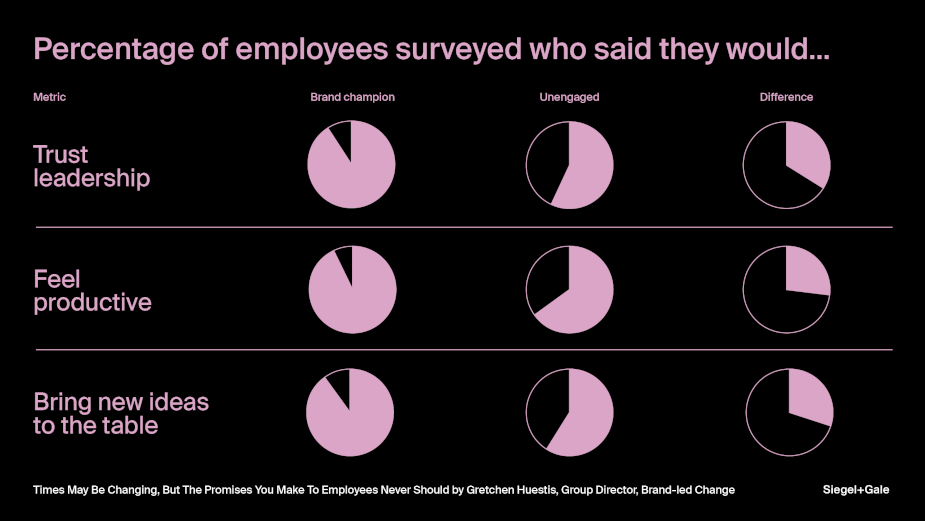This article originally appeared in Little Black Book.
It’s hard to avoid getting caught up in competing buzzwords and headlines. Employers’ scramble to retain talent during The Great Resignation was quickly replaced with their fear of having to quantify talent due to an alleged, impending, economic recession. One minute employees were ‘quiet quitting‘ and the next they were ‘fast quitting‘… or were their noses back to the grindstone due to sweeping layoffs?
Talent has been trapped in a spin cycle of conflicting messaging, too. For example, while some companies evangelize an eternal Work From Home model, others are mandating a full Return To Office – sometimes gently with promises of surface-level bribery (Salt crystals! Sprinkles! Remember free food?); sometimes with threats (comply or fly). Others, still, are oscillating between options, constantly switching policies.
All these mixed messages have left everyone feeling dizzy. And the only way to get everyone back on track is to stop reading (and reacting) to every headline, stop trying to predict an unpredictable future, and actually start looking at your company’s past.
To find stability in a turbulent time, companies need to take a step back and realign with their brand purpose and core values. Yes, the way we work has fundamentally changed. But what hasn’t, or at least shouldn’t, change is what we stand for as an organization and how that shapes the way we treat and listen to our employees.
How to make authentic promises
If the last few years have taught us anything, it’s that we can’t predict the unpredictable. But we can create and communicate actions and policies intentionally, authentically, and transparently.
The first step is revisiting your Employee Value Proposition (EVP): The promise that encapsulates the compelling bond between your people and your organization. It is the direct reflection of your distinct brand and signals what employees can uniquely experience in their work. This EVP should have alignment to and reflect the overarching brand purpose of the organization – a statement of why you exist and what you stand for. It also serves as the other side of the coin to your organization’s values. If the EVP shares what is promised as an employee experience, the values set out how the organization and everyone inside it need to behave every day in order to make that experience real.
If your purpose, EVP or organizational values aren’t explicit, strengthen them. If they aren’t visible – for example, if your companies’ values were written across the halls, a lobby your now exclusively remote workforce no longer walks through on a daily basis – promote them, both to employees and leadership. These items are the filter leaders must use to make every single decision. That way you are building strategies based on what you stand for and the fundamental promises you want to make to your employees. Promises you know you can commit to keeping.
If you start with a reflection about what you stand for, marry that with authentic consideration of what matters most to your employees and then create experiences that deliver on those needs, it will pay off tenfold.
Explain, engage, and excite people in the promise of their brand
As people have spent the last few years reckoning with a global pandemic, political unrest, and racial injustice, they’ve redefined how they see the world and what matters most to them. So, it makes sense that they’d want to extend their value system to more aspects of their lives… including their workplace. Furthermore, talent is demanding that their employers be more human and treat them with respect, compassion, and dignity.
Our World’s Simplest Brands study surveyed more than 15,000 people across nine regions about the workplace. It found that employees’ top reasons for wanting to stay and invest in a company were: connections with other people, workplace security, the degree to which DEIB (Diversity, Equity, Inclusion and Belonging) is in action, and the alignment of an employee’s values to what the company holds up as sacred. Put another way: employees care about the human, often more intangible, side of their work experience, the promises behind them and how well you keep them.
In our experience, however, these are areas in which companies typically over-promise and underinvest. Following through on commitments aligned with those values, however, are keyways to turn employees into brand champions.
Building brand champions is the key to long-term success
Our research revealed that supporting the more humanistic parts of the workplace experience impacts more than just employee retention. Rather, it caters to a subset of the employee population known as ‘Brand champions.’
Brand champions are members of the workforce who have strong alignment with their company’s values and understand what the brand stands for and is committed to. They are also more likely to advocate and even evangelize on behalf of their company. Through their daily work, they lean in, doing their part to further the delivery of the brand promise.
In addition to fueling growth and forward momentum for organizations, they also provide tangible benefits that contribute to stronger business performance. For example, nine out of 10 brand champions report that they trust company leadership, feel productive at work, and will try to bring new ideas to the table in work matters. By comparison, unengaged employees were considerably less likely to do any of those valuable actions.

And the positive impact of an authentically evangelising employee has the power to impact far more than the internal operations of a company. These champions have the power to shape the external narrative about your organisation. When a brand champion shares their views, friends, family members, or even occasional social media acquaintances will take that message to heart, too. Your employees’ reach in telling the story of your organisation outstrips that of the corporate entity. For example, LinkedIn reports that brand messages distributed by employees are re-shared 24 times more often than company distributed messages. Beyond reach, employee-generated content is also consumed with a different level of trust. Employees are repeatedly cited as one of the most credible sources of information about a company. In these times where marketing budgets might be getting trimmed, a cadre of Brand Champions can be a powerful tool that comes at a very reasonable investment. But cultivating this group comes back to the principle of standing by what you say you stand for as an organisation and using that to direct the way you treat and listen to your employees.
With change as the only constant, we have probably not seen the end of turbulent times. All the more reason to revisit your brand purpose and its associated values, which might have once seemed intangible, and bring them forward into a very tangible employee experience. This gives people something to hold on to and will keep them moving forward for their own benefit as well as that of the organization.
Gretchen Huestis is Group Director, Brand-led Change


